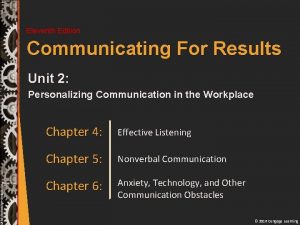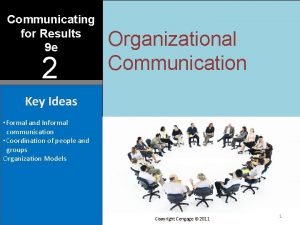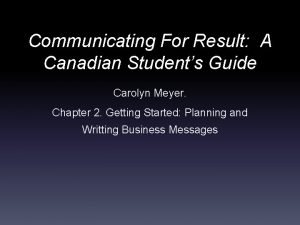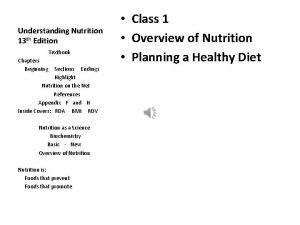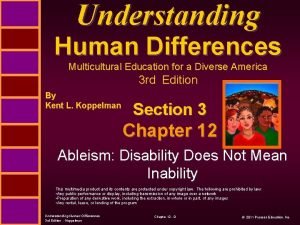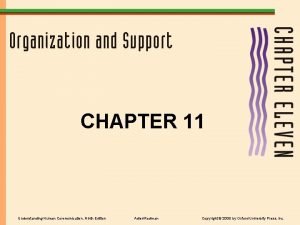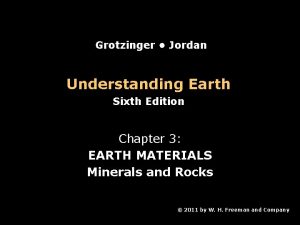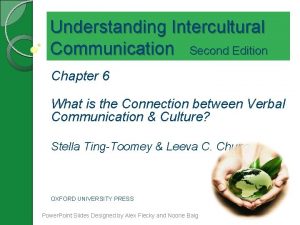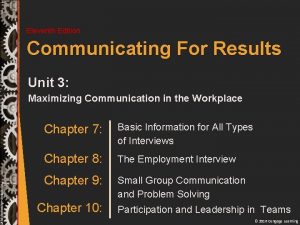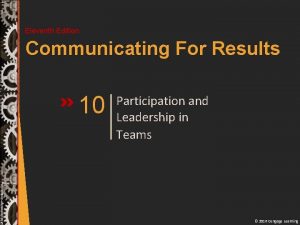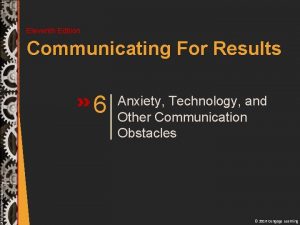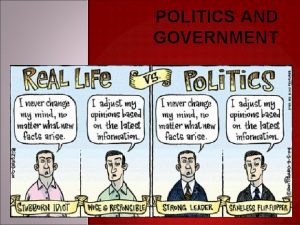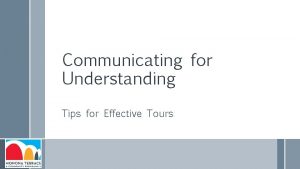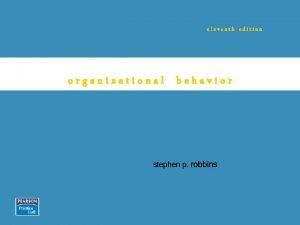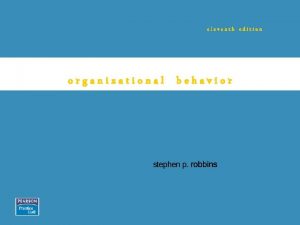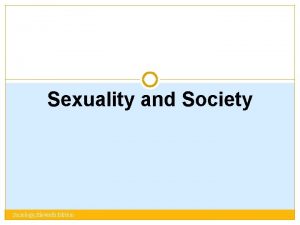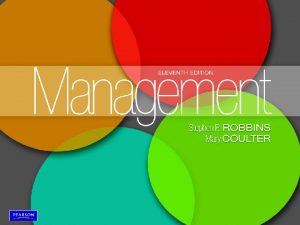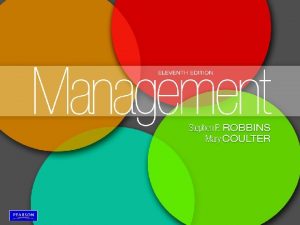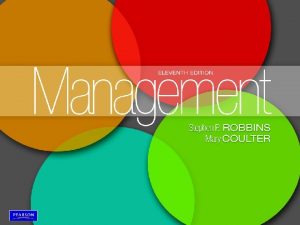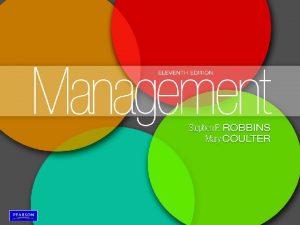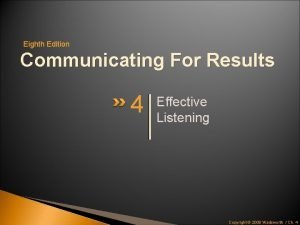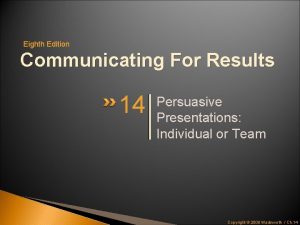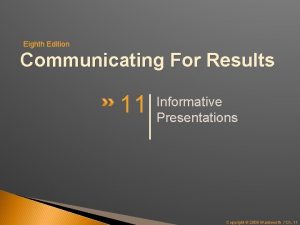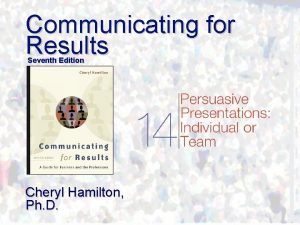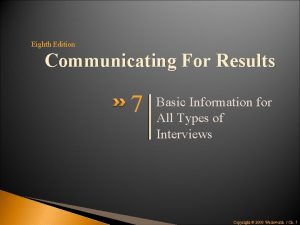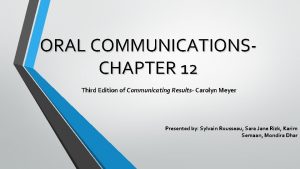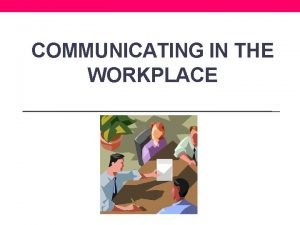Eleventh Edition Communicating For Results Unit 1 Understanding































- Slides: 31

Eleventh Edition Communicating For Results Unit 1: Understanding Communication in the Workplace Chapter 1: Chapter 2: Chapter 3: Communication and Ethics at Work: What should you know? Organizations in the Workplace: Which ones fit you best? Handling Conflict, Cultural Diversity, and Relationships. © 2016 Cengage Learning

Eleventh Edition Communicating For Results 1 Communication and Ethics at Work: What should you know? © 2016 Cengage Learning

Walmart: Real-Life Case “Choices and Challenges” q Read or describe the real-life case. q Answer the questions for Ch. 1: − Basic communication used? (See pg. 3) − Ethical standards? (See pg. 3) − Formal communication used? (See pg. 3) © 2016 Cengage Learning

1 Really? “ 14 percent of each 40 -hour workweek is wasted because of poor communication between staff and managers—amounting to a stunning seven weeks a year” (Thomas, 1999, p. 1). Thomas, J. (1999). So you hear what I hear? Women in Business, 51(1), 1 -14. © 2016 Cengage Learning

Communication Models q One-Way Model q Circular Model q Transaction Model © Phil Boorman/Age. Fotostock © 2016 Cengage Learning

One-Way Model: Figure 1. 1: Communication viewed as linear—from person A to B © Phil Boorman/Age. Fotostock © 2016 Cengage Learning

Communication Code Includes. . . q Language (verbal)—spoken or written words. q Paralanguage (vocal)—tone, pitch, volume. q Nonverbal (visual)—eye contact, facial expressions, posture, etc. Vocal & Visual Code 69% Verbal Code 31% © Phil Boorman/Age. Fotostock © 2016 Cengage Learning

Test Your Knowledge! In small groups, answer these questions about channels. . . 1. Name five communication channels. 2. Which are called “rich” channels? Why? 3. Which channel is more synchronous: e-mail or face -to-face? Why? 4. Message complex/emotional—which channel best? 5. Message explicit/obvious—which channel best? (See Table 1. 2) © Phil Boorman/Age. Fotostock © 2016 Cengage Learning

Circular Model: Figure 1. 2: Communication viewed as a circular or interactive process involving feedback and frame of reference © Phil Boorman/Age. Fotostock © 2016 Cengage Learning

Test Your Knowledge! In small groups, answer these questions. . . 1. Name five things that make up frame of reference. 2. Can any two people have identical frames of reference? Why or why not? 3. Fill in: “The only message that counts is ____. ” 4. What role does culture play in frame of reference differences? Give examples & see Table 1. 1. © Phil Boorman/Age. Fotostock © 2016 Cengage Learning

Table 1. 1: Differences in Cultural Values American (US) Japanese Vietnamese 1. Enjoying life 1. Being healthy 1. Having deep respect for parents and grandpa 2. Being a good person 2. Avoiding war 2. Taking care of my parents when they get old 3. Having a personally fulfilling life 3. Treating human life as precious 4. Having love 4. Having close, supportive friends 4. Following my conscience & doing right 5. Having someone I can really talk to 5. Having a world free of war 5. Not dishonoring my family 6. Choosing my own goals 6. Making friends 6. Fulfilling family obligations 7. Being true to myself 7. Having someone I can really talk to 7. Being employed 8. Finding a mate with good qualities 8. Having a positive outlook on life 8. Being healthy 9. Having wisdom 9. Enjoying life 9. Being responsible 10. Being independent & self-reliant 10. Having love 10. Having a secure job Source: Roy D’Andrade. (2008). A Study of Personal & Cultural Values: American, Japanese, & Vietnamese. New York, NY: Palgrave Mac. Millan, p. 63. © Phil Boorman/Age. Fotostock © 2016 Cengage Learning

When Receiving Feedback Ques: Which two are the most important? Why? 1. Identify specific feedback desired 2. Set aside time for feedback sessions 3. Select proper channel richness 4. Use silence/watch for responses 5. Encourage/reward feedback 6. Ask questions/paraphrase 7. Follow-up © Phil Boorman/Age. Fotostock © 2016 Cengage Learning

When Giving Feedback Ques: Which two are the most important? Why? 1. Is directed toward behavior (not person) 2. Is descriptive not evaluative 3. Involves sharing (not giving advice) 4. Includes limited information 5. Is immediate & well-timed 6. Allows for face-saving © Phil Boorman/Age. Fotostock © 2016 Cengage Learning

Transaction Model: Figure 1. 3: Communication viewed as a simultaneous process that occurs when frames of reference of persons A & B overlap creating meaning © Phil Boorman/Age. Fotostock © 2016 Cengage Learning

Test Your Knowledge! In small groups, answer these questions. . . 1. Define internal and external stimulation. 2. Just because you are stimulated, doesn’t mean you will communicate—what is missing? 3. Best business meeting time: 8: 00 a. m. , 10: 00 a. m. , or 4: 00 p. m. ? Why? 4. What role does overlapping frames of reference play in successful communication? © Phil Boorman/Age. Fotostock © 2016 Cengage Learning

1 Polishing Career Skills How skilled a communicator are you? Check answers on pg. 22 of book © 2016 Cengage Learning

How Communication Flows Inside the Organization © Phil Boorman/Age. Fotostock © 2016 Cengage Learning

Communication Networks How communication flows in the workplace. . . q Formal communication network: “Official paths prescribed by the organization’s chain of command. ” q Informal communication network: “Unofficial paths based on friendships or specific information needs. ” © Phil Boorman/Age. Fotostock © 2016 Cengage Learning

Formal Communication Includes 3 types of communication. . . Downward Messages flow downward through the chain of command (from manager to employee). © Phil Boorman/Age. Fotostock © 2016 Cengage Learning

Formal Communication Includes 3 types of communication. . . Downward Upward Messages flow upward through the chain of command— i. e. , from employee to boss. © Phil Boorman/Age. Fotostock © 2016 Cengage Learning

Formal Communication Includes three types of communication. . . Horizontal Downward Upward Messages flow laterally between people of the same rank. © Phil Boorman/Age. Fotostock © 2016 Cengage Learning

Downward Communication Normally Includes. . . 1. Employee performance appraisals 2. Job instructions 3. Job rationale 4. Policy & procedures 5. Motivational appeals © Phil Boorman/Age. Fotostock © 2016 Cengage Learning

Upward Communication Normally Includes. . . 1. Employee work, achievements, & progress 2. Employee opinions & feelings 3. Outlines of work problems 4. Ideas for improvement © Phil Boorman/Age. Fotostock © 2016 Cengage Learning

Horizontal Communication Especially important for. . . 1. Coordinating tasks 2. Solving complex problems 3. Sharing information 4. Resolving conflicts 5. Empowering teams © Phil Boorman/Age. Fotostock © 2016 Cengage Learning

Informal Communication Often called the “Grapevine”. . . 1. Indicates the health of the organization 2. Adds to employee satisfaction & commitment 3. Indicates employee concerns 4. Is 75 95% accurate 5. Travels fast © Phil Boorman/Age. Fotostock © 2016 Cengage Learning

Ethics Inside the Organization © Phil Boorman/Age. Fotostock © 2016 Cengage Learning

Ethics Defined “Ethics…are the standards by which behaviors are evaluated for their morality; their rightness or wrongness” (Shockley-Zalabak, 2015, p. 112) Bernie Madoff (150 -year sentence) © Phil Boorman/Age. Fotostock Peter Madoff (10 -year sentence) © 2016 Cengage Learning

Four Ethical Rules Base business decisions on these rules. . . q The utilitarian rule q The moral rights rule q The justice rule q The practical rule Survey of 2, 300 employees – 75% reported observing a violation of company standards during the previous year (Lamb, et al. , 2004). © Phil Boorman/Age. Fotostock © 2016 Cengage Learning

Ethics Traps Which ones tempt you? q Trap of necessity q Trap of end justifies the means q Trap of rationalization q Trap of self-deception q Trap of relative filth © Phil Boorman/Age. Fotostock Bernie Madoff (150 -year sentence) © 2016 Cengage Learning

1 Awareness Check PRCA-24 Pre-Test Directions: Complete Mc. Croskey’s PRCA-24. For each of the following questions, think about your communication in general and mark the degree that each statement applies to you on a 5 -point scale: 1 (Strongly Agree) 2 (Agree) 3 (Undecided) 4 (Disagree) 5 (Strongly Disagree) ___1. I dislike participating in group discussions. ___2. Generally, I am comfortable while participating in a group discussion. ___3. I am tense and nervous while participating in group discussions. ___4. I like to get involved in group discussions. ___5. Engaging in a group discussion with new people makes me tense and nervous. ___6. I am calm and relaxed while participating in a group discussion. ___7. Generally, I am nervous when I have to participate in a meeting. ___8. Usually I am calm and relaxed while participating in meetings. ___9. I am very calm and relaxed when I am called upon to express an opinion at a meeting. ___10. I am afraid to express myself at meetings. ___11. Communicating at meetings usually makes me uncomfortable. ___12. I am very relaxed when answering questions at a meeting. ____ 13. While participating in a conversation with a new acquaintance, I feel very nervous. ____ 14. I have no fear of speaking up in conversations. ____ 15. Ordinarily I am very tense and nervous in conversations. ____ 16. Ordinarily I am very calm and relaxed in conversations. ____ 17. While conversing with a new acquaintance, I feel very relaxed. ____ 18. I’m afraid to speak up in conversations. ____ 19. I have no fear of giving a speech. ____ 20. Certain parts of my body feel very tense and rigid while I am giving a speech. ____ 21. I feel relaxed while giving a speech. ____ 22. My thoughts become confused and jumbled when I am giving a speech. ____ 23. I face the prospect of giving a speech with confidence. ____ 24. While giving a speech, I get so nervous I forget facts I really know. See scoring and assessment on p. 7 and in Mind. Tap. . © 2016 Cengage Learning

1 The End © 2016 Cengage Learning
 Communicating for results 11th edition
Communicating for results 11th edition Communicating for results 11th edition
Communicating for results 11th edition Eleventh edition management
Eleventh edition management Management eleventh edition stephen p robbins
Management eleventh edition stephen p robbins Management eleventh edition
Management eleventh edition Management eleventh edition stephen p robbins
Management eleventh edition stephen p robbins Persistent processus vaginalis
Persistent processus vaginalis Communicating for results a canadian student’s guide
Communicating for results a canadian student’s guide Chadha committee
Chadha committee Eleventh 5 year plan
Eleventh 5 year plan Eleventh plan
Eleventh plan For his eleventh birthday elvis presley
For his eleventh birthday elvis presley Understanding nutrition 13th edition rental
Understanding nutrition 13th edition rental Understanding movies 14th edition
Understanding movies 14th edition Understanding human differences 5th edition
Understanding human differences 5th edition Understanding earth 7th edition
Understanding earth 7th edition Covergent boundary
Covergent boundary Understanding earth 5th edition
Understanding earth 5th edition Adler and rodman 2006
Adler and rodman 2006 Business essentials 12th edition
Business essentials 12th edition Adler and rodman 2006
Adler and rodman 2006 Earth 6th edition
Earth 6th edition Linear vs relational worldview
Linear vs relational worldview Using mis (10th edition) 10th edition
Using mis (10th edition) 10th edition Mis
Mis Unit 10, unit 10 review tests, unit 10 general test
Unit 10, unit 10 review tests, unit 10 general test Fspos
Fspos Typiska drag för en novell
Typiska drag för en novell Tack för att ni lyssnade bild
Tack för att ni lyssnade bild Ekologiskt fotavtryck
Ekologiskt fotavtryck Varför kallas perioden 1918-1939 för mellankrigstiden
Varför kallas perioden 1918-1939 för mellankrigstiden En lathund för arbete med kontinuitetshantering
En lathund för arbete med kontinuitetshantering
